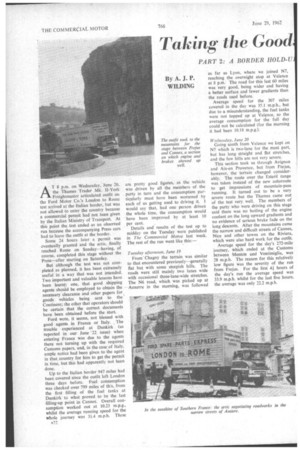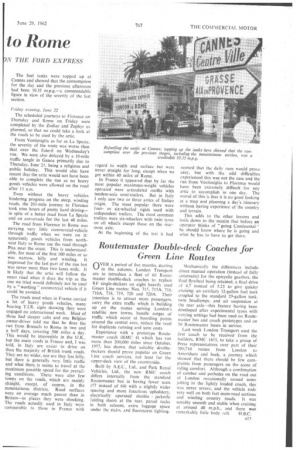Taking the Good
Page 56

Page 57

If you've noticed an error in this article please click here to report it so we can fix it.
to Rome
PART 2: A BORDER HOLD-U 9N THE FORD EXPRESS
By A. J. P. WILDING
AT 8 p.m. on Wednesday, June 20, the Thames Trader Mk. II-York Freightmaster articulated outfit on the Ford Motor Co.'s London to Rome test arrived at the Italian border, but was not allowed to enter the country because a commercial permit had not been given by the Italian Ministry of Transport. At this point the test ended as an observed run because the accompanying Press cars had to leave the outfit at the border.
Some 24 hours later a permit was eventually granted and the artic, finally reached Rome on Sunday--having, of course, completed this stage without the Press—after starting on Saturday.
But although the test was not completed as planned, it has been extremely useful in a way that was not intended. Two important and valuable lessons have been learnt: one, that good shipping agents should be employed to obtain the necessary clearance and other papers for goods vehicles being sent to the Continent; the other that operators should be certain that the correct documents have been obtained before the start.
Ford were, it seems, not blessed with good agents in France or Italy. . The trouble experienced at Dunkirk (as reported in our June '22 issue) when entering France was due to the agents there not turning up with the required Customs papers, and, in the case of Italy. ample notice had been given to the agent in that country for him to get the permit in time, but this had apparently not been done.
Up to the Italian border 947 miles had been covered since the outfit left London three days before. Fuel consumption was checked over 799 miles of this, from the first filling of the fuel tanks at Dunkirk to what proved to be the last filling-up point in Cannes. Overall consumption worked out at 10.23 m.p.g., whilst the average running speed for the whole journey was 31.4 m.p.h. These R22 are pretty good figures, as the vehicle was driven by all the members of the party in turn and the consumption particularly must have been worsened by each of us getting used to driving it. I would say that, had one person driven the whole time, the consumption would have been improved by at least 10 per cent.
Details and results of the test up to midday on the Tuesday were published in The Commercial Motor last week. The rest of the run went like this:—
Tuesday afternoon, June 19
FromChagny the terrain was similar to that encountered previously—generally flat but with some steepish hills. The roads were still mainly two lanes wide with occasional three-lane-wide stretches. The N6 road, which was picked up at Auxerre in the morning, was followed
as far as Lyon, where we joined N7, reaching the overnight stop at Valence at 8 pan. The road for this last 60 miles was very good, being wider and having a better surface and fewer gradients than the roads used before.
Average speed for the 307 miles covered in the day was 35.1 m.p.h., but due to a misunderstanding, the fuel tanks were not topped up at Valence, so the average consumption for the full day could not be calculated (for the morning it had been 10.18 m.p.g.).
Wednesday, June 20 Going south from Valence we kept on N7 which is two-lane for the most part, but has long straight and flat stretches, and the few hills are not very severe.
This section took us through Avignon and Aix-en Provence, but from Frejus, however, the terrain changed considerably. The route over the Esteril range was taken instead of the new autoroute to get impressions of mountain-pass running. It turned out to be a very severe route but the Thames came out of the test very well. The members of the party who were .driving on this stage said there was no boiling of the engine coolant on the long upward gradients and no evidence of serious brake fade on the long descents. After the mountains came the narrow and difficult streets of Cannes, Nice and other towns on the Riviera, which were also hard work for the outfit.
Average speed for the day's 272-mile journey, Which ended at the Customs between Mentor' and Ventimiglia, was 28 m.p.h. The reason for this relatively low figure was the severity of the run from Frejus. For the first 4:1 hours of the day's run the average speed was 33.9 m.p.h. whilst for the last five hours, the average was only 22.2 m.p.h. The fuel tanks were topped up at Cannes and showed that the consumption for the day and the previous afternoon had been 10.35 m.p.g.—a commendable figure in view of the severity of the last section.
Friday evening, June 22 The scheduled journeys to Florence on Thursday and Rome on Friday were completed by the Zodiac and Zephyr as planned, so that we could take a look at the roads to be used by the artic.
From Ventimiglia as far as La Spezia, the severity of the route was worse than that over the Esteril on Wednesday's run. We were also delayed by a 10-mile traffic tangle in Genoa primarily due to Thursday, June 21, being a religious and public holiday. This would also have meant that the artic would not have been able to complete the run as no heavy goods vehicles were allowed on the road after II a.m.
Even without the heavy vehicles hindering progress on the steep, winding roads, the 281-mile journey to Florence took nine hours of pretty hard driving— in spite of a better road from La Spezia and an autostrada for the last 40 miles.
The road from Florence to Rome was carrying very little commercial-vehicle through traffic when we were on it: apparently goods vehicles from northwest Italy to Rome use the road through Pisa near the coast. This is understandable, for most of the first 100 miles or so was narrow, hilly and winding. It improved for the last part of the run but was never more than two lanes wide. It is likely that the artic will follow the coast road when it does the trip as the one we tried would definitely not be used by a " working " commercial vehicle if it could be avoided.
The roads used when in France carried a lot of heavy goods vehicles, many bearing T.I.R. signs showing they were engaged on international work. Most of these had sleeper cabs and one Belgian owner-driver told me that he does the run from Brussels to Rome in two and a half days, covering 500 miles a day. This would be impossible in the U.K., but the main roads in France and, I was told, in Italy are easier to drive on than the majority of British trunk roads. They are no wider, nor are they less hilly, but there is generally very little traffic and what there is seems to travel at the maximum possible speed for the prevailing conditions. There were also few towns on the roads, which are mainly straight, except, of course, in the mountainous districts. Road surfaces were on average much poorer than in Britain—in places they were shocking. The roads actually used in Italy were comparable to those in France with
regard to width and surface but were never straight for long, except when we got within 40 miles of Rome.
In France it appeared that by far the most popular maximum-weight vehicles operated were articulated outfits with tandem-axle semi-trailers. But in Italy I only saw two or three artics of Italian The most popular there were fouror six-wheeled rigids used with independent trailers. The most common trailers were six-wheelers with twin tyres on all wheels except those on the rearmost axle.
At the beginning of the test it had
seemed that the daily runs would prove easy, but with.the odd difficulties experienced --this was not the case and the run from Ventimiglia to Florence would have been extremely, difficult for any artic to accomplish in one day. The moral of this is that it is no good looking at a map and planning a day's itinerary without having experience of the country and terrain.
This adds to the other lessons and boils down to the maxim that before an operator thinks of "going Continental" he should know where he is going and what he has to have to get there.
















































































































































